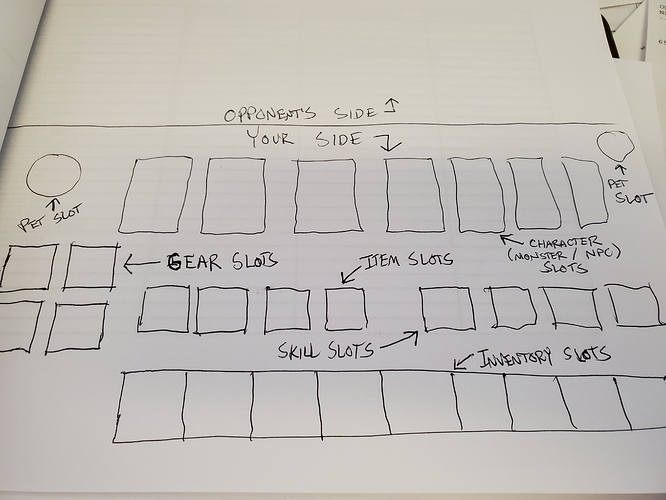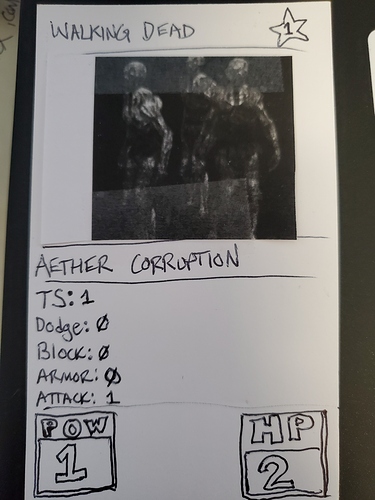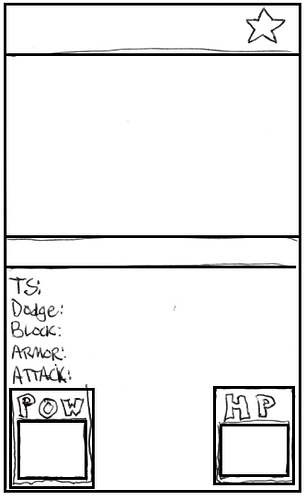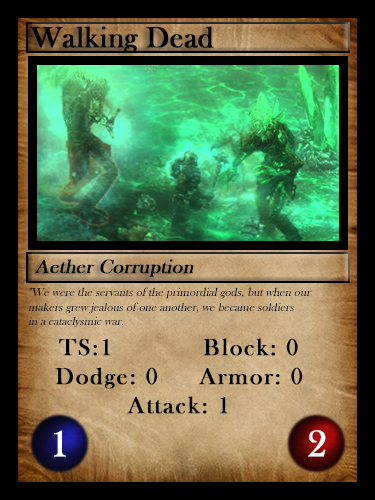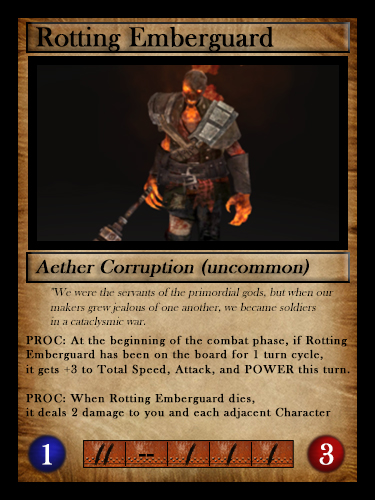Hey guys,
Inspired by @all_zebest board game post, I have decided to share what i have so far relating to my design for a Grim Dawn CCG/Deckbuilder game, which I am not designing for profit, but rather donating as an idea to the community and to Crate, in the hopes something could come of it!
Id love the communities feedback, ideas, and even contributions. My dream would be for all of us here on the forums to collaborate and create at least the mechanical aspects of this game concept, so that any of us (hopefully Crate, but i am not expecting anything!) Could create it using either programs or even actual cards and game board, and then donate to Crate so they could do whatever they wanted with it.
So without getting too long winded, heres the bit I have so far. PLEASE KEEP IN MIND this is nowhere close to being complete, and is just the current vision I have for the game, several significant elements to it have yet to be hashed out.
I can include drawings of the playmat (game board) to help visualize, just havent done that yet.
EDIT: Due to many changes to the game as its been developed over time, I am giving this post an overhaul to update it. Below I have now posted the current, updated format of the game phases, and will continue to update each of the posts I’ve made so far in this thread to correct for any inconsistencies or omissions. I will also include a single post containing all the current Keywords. This is a work in progress that I am quite passionate about.
Ive also included a walkthrough of the first 2 turns playing in the Single Player mode, with pictures included for aid in visualization.
Grim dawn CCG;
This deckbuilding CCG pits players against eachother in 1v1 matches, wherein the players strive to eliminate each other by reducing their opponents HP to 0. All the while each player must slay Monsters to gain levels and get loot, which in turn makes the player stronger, but also adds stronger Monsters to the game. The first player whose HP hits 0 loses. The game can also be played single player, though the rules are slightly different in that mode. Co-op and Crucible are also other gameplay options, but again, with slightly different rules. To explain how all these play modes work, I first need to explain how to play the standard way (1 v 1, aka PvP).
HOW IT WORKS;
Players begin the game with 20 HP, 20 Constitution, and a 10 card deck. The cards in this deck can be any 10 cards from your Stash, but must adhere to the following specifications;
2 Common Item/Gear cards
8 level 1 Monster cards
BUT WHAT IS “MY STASH”?
Your Stash is basically your Sideboard. This is a zone outside the game where you keep all the cards you own, and pull cards from when gaining levels and building your deck. We will touch on this later.
After both players have shuffled their 10 card decks, they take turns choosing a Common level 1 gear set and a Common level 1 weapon from their Stash, and equip them.
At this point in time, players flip a coin to determine who goes first, then both players draw 3 cards. The player who goes first then begins their first turn.
PHASES OF A TURN;
-
Constitution check: Constitution is a resource similar to HP, which behaves like an auto-heal. At the beginning of each players turn, during the Constitution check phase, the game checks to see if the player took any damage during their previous turn. If that answer is no, the player restores their HP to their starting HP total, then subtracts that amount from their Constitution. If the answer is YES, however, the player will not recover any HP, and their Constitution will remain the same. Constitution can only be recovered by using certain items, and once depleted, no additional healing will be applied in this way.
-
Draw: Following the Constitution Check, the player draws a card. Cards drawn are automatically placed face-up on the table in their appropriate location (slot), unless the card drawn is an Event card. Event cards will execute various actions automatically when drawn, affecting or changing the game in different ways before being removed from the game once their effects resolve.
Players don’t hold any cards in-hand in this game. The closest thing to a hand in this game is the Inventory slots, where excess Items and Gear can be stored, face up on the game board. Items are otherwise placed in item slots (components, augments, and consumables), and Gear is placed in Gear slots. Monsters and NPCs are placed in “Character” slots. (Character is a term used to include both NPCs and Monsters). Pets are placed in Pet slots.
WHOA WHOA, WAIT A MINUTE… WHAT ARE ALL THESE SLOTS?
Slots are spaces on the game board which are designated to hold cards of a certain type. These card types are placed in their respective slots when drawn in order to keep the board clean and organized, so that both players may clearly see whats on the board at all times.
At its current stage of experimentation, I am working with max slots configured as such for each player; 7 Character slots, 4 Pet slots, 4 Gear slots, 4 Item slots, and 4 Inventory slots. This can be changed around whenever, its less important than the actual game mechanics themselves, although amounts of slots for card types does have a huge impact on the game mechanics and vice versa. Read on to see why!
SLOT PLACEMENT, FULL INVENTORY, AND SCRAPPING/STASHING
If a player’s Item/Gear slots are full, Item/Gear cards will automatically be placed in any available Inventory slot when drawn. If all Inventory slots are full when a player draws an Item or Gear card, they can do one of two things; Scrap, or Stash.
SCRAP
Some Item and Gear cards have a “Materials” section. When an Item or Gear card is Scrapped, it’s removed from the game completely (no longer accessible during the match by any means) in exchange for the indicated Materials it generates upon Scrapping. These Materials, or “Mats” for short, are indicated in the Materials section on the card, and are generally rare Components that cant be gotten any other way. Components received from Scrapping can be fitted onto Gear immediately at this time, otherwise they are removed from the match entirely.
STASH
Stashing is a lot simpler than Scrapping. If you happen to draw an Item or Gear card, but your Item, Gear, and Inventory slots are already occupied, and you dont want to Scrap it, you can choose to Stash it instead, which simply returns the card to your Stash (Sideboard).
Some Monsters and NPCs also provide loot when theyre killed. These specifics are detailed in the card text, and will generally either instruct the player to shuffle the loot into their deck, or give them the option to equip/consume it immediately. Sometimes, the player may have the option to hold the loot in one of their Inventory slots, if any are available.
DRAWING MONSTER AND NPC CARDS
Important to note is that when you draw a Monster card, it is placed in any available Character slot on your OPPONENT’S SIDE of the board(Opponent’s Territory), while NPCs are placed in any available Character slot on YOUR SIDE of the board (Your Territory). If no slots are available, the Monster or NPC card goes to the bottom of your deck. When this occurs, you do not draw again, your draw phase simply ends.
OTHER SLOTS
There are also Skill card slots. But we’ll touch on these later.
HOW DO I GET ITEMS, MONSTERS, AND NPC CARDS IN MY DECK?
To explain how decks are built over the course of the game (adding Item, Monster, and NPC cards) we must first explain Levels and Levelling.
LEVELS AND LEVELLING
As players defeat Monsters, they will gain experience (XP). Each monster, and NPC has a “Level”. This number is indicated in the upper right hand corner of the card. A Monster or NPC will provide an amount of XP to the player equal to that Monster or NPC’s Level when eliminated. IE; a level 2 monster provides 2 XP.
The XP threshold for players to gain a level is equal to the number of turns theyve taken so far. So on your first turn your XP threshold is 1. To gain a level, all you have to do is destroy a single level 1 Monster or NPC. This will net you 1 XP. On your 5th turn, however, you will have to defeat Monsters or NPCs whose accumulated Level value equals 5 (IE; a level 2 Monster/NPC and a level 3 Monster/NPC. Or five level 1 Monster/NPCs. Or one level 5 Monster/NPC. Etc).
If you defeat Monsters/NPCs whose totalled XP values exceed your XP threshold (IE; 4 XP on turn 3), you will gain a Devotion point. Devotion points are like Skill points, only they are used to unlock Devotion abilities specifically. More on Skills and Devotions later. While players retain their levels, Player XP resets every turn, always beginning each turn at 0, regardless of player level.
OKAY, SO WHAT HAPPENS WHEN I LEVEL UP?
The first time a player gains a level, they get to choose their base class and get 2 Skill points. Skill points are used to unlock Skill cards. Each Skill card has a level, and when you first gain a level you can unlock a level 1 and a level 2 Skill card, or 2 level 1 skill cards. After gaining their first level, players only get 1 Skill point per level when they level up. More on Skill cards later.
Next, the player chooses from their Stash any combination of 2 Level 2 Item and/or NPC cards, and 2 level 2 Monster cards, and shuffles them into their deck (a total of 4 cards). The Level and # of Item/NPC, and Monster cards chosen when gaining a level must be equal to the player’s Level. For instance, at level 5, the player must add to their deck any combination of 5 level 5 item and/or NPC cards, as well as 5 level 5 Monster cards (a total of 10 cards).
Once a player has chosen their base class after gaining their first level, each subsequent level gained will provide them with 1 Skill Point, allowing them to either unlock 1 new skill card equal to, or below, their level- OR empower a skill card theyve already unlocked, but not both. Items, Monsters, and NPCs are always added to decks each level as well, in order to create a constantly evolving board presence that grows in threat as the players get stronger.
Also, at level 10, the player gets the option to dual-class. If they choose to, they will then get their choice of 1 unique dual-class card, which exhibits powerful effects on gameplay, designed to close out the match. But more on that later!
OKAY, HOW DO I FIGHT THESE SUMBITCHES?
This brings us back to the phases of a turn. If you remember, we sort of branched off after covering the 2nd turn phase (Draw). To answer this question we will have to go to the next turn phase;
- Combat phase: After the Draw phase is concluded, the Combat phase begins. All Cooldowns on face-down Active Skills are checked at this time, and if found to be 0, are flipped back face-up (ready to use).
Combat deals with the “Territory” of both players. Territory is the term used to define a player’s side of the game board, and plays a huge role in combat mechanics, which are a little different in this game than in its peers. Players dont technically control Monsters, and very little control is implemented in regard to the NPCs. Each Monster, NPC, Pet, and Player has stats. These stats are what determine their flexibility and functionality in the Combat phase. These stats are;
Power: The amount of damage the character’s basic attacks deal.
Speed: The overall speed of the character. A higher number means theyre faster, which means their actions take priority first during the Combat phase.
Defensive Ability (DA): Determines a characters probability to block/dodge/evade. If this number is higher than the OA of whatever is targeting the character, the character will block/dodge/evade, negating all effects completely.
Offensive Ability (OA): Determines a characters probability to hit. If this number is higher than the target’s Defensive Ability (DA), the attack or skill will hit successfully.
Armor rating: How much damage gets mitigated from damaging attacks and skills that target the character and hit successfully.
HP: the health of the character. When it reaches 0, it dies and is removed from the game. If its a Monster, its placed in the Shattered Realm pile instead.
ALRIGHT, BUT HOW DOES THE FIGHTING ACTUALLY WORK?
Combat takes place almost autonomously, with the character who has the highest Speed value going first. Characters cannot have a Speed thats less than 0, so if a card or effect would reduce a Character’s Speed below 0, it reduces that Character’s Speed to 0 instead. A character with 0 Speed takes action last. If 2 Characters are tied for Speed, Monsters always go first, then NPCs, then players.
Monsters always attack the player whose Territory they are on. They cant attack NPCs or eachother directly, unless certain cards or effects enable this.
NPC target priority is Monster cards, and they will automatically attack any Monster card in adjacent Character slots. If Monster cards are in both adjacent slots to an NPC card (one on the right, and one on the left), the NPC will always attack the Monster on the right side first.
NPCs can also attack the opponent’s NPCs, but will only be able to do this if there are no Monster cards in their Territory. Some NPCs also have Active skills built into them, giving the player a little more control over their behavior in combat, and allowing for some tactical depth.
Players can target Monsters and NPCs in either territory freely with their attacks and skills (unless otherwise prevented by a card or effect), but cannot target their opponent directly with attacks and skills unless there are no Monsters in their Territory, and the opponent has no NPCs in their Territory. In other words, you cant attack or use skills on your opponent directly unless they have no NPCs in their territory, and you have no Monsters in your territory.
By default, each player can only attack a single time on their turn unless the effect of a card allows otherwise. After attacking, the player flips their Weapon card face-down, as though its on Cooldown. Also, each player can only use 1 Skill Card of each type during their turn, unless the effect of a card allows otherwise. Skill Cards generally have a Cooldown, and are flipped face-down after use to indicate they are on Cooldown. The backside of each Skill Card has a number on it, which indicates the number of Cooldown Coins to be placed on it. At the beginning of each turn, 1 Cooldown Coin is removed. When 0 remain, the Skill Card flips face-up and can be used again. Once all characters have taken action, the Combat phase ends, and the Level Up phase begins.
-
Level Up: At the beginning of this phase, the game checks if the active player gained enough XP to Level Up. If the player did, it’s at this time that he or she assigns the skill point and chooses cards from his or her Stash to add to their deck.
-
Gear phase: During this phase, players can equip different Gear they have acquired during the game, and add/remove Augments and Components. Players can only equip 1 card of each Gear type per turn, IE: 1 Weapon/Shield/Off-hand, 1 Armor, 1 Accessory, and 1 Relic.
Due to limited board space, and in an attempt to simplify the game and slim down on its already sufficient complexity, Armor Sets are grouped together on a single card as a Gear Set. There are no separate Armor Gear cards for set Boots, Pants, Shoulders, Gloves, Chests, or Helmets, in other words. As a result of this, Armor Gear that are sets in GD will be represented on a single card in this game and are therefore inherently more powerful, and thus, more rare. Armor Gear Sets are given the Legendary rarity for this reason.
- End of turn.
